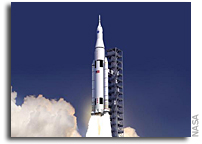Report Reviews Funding and Management Problems Facing Space Launch System

NASA is developing the first of three rockets for the human exploration of space beyond low-earth orbit. The first flight of a Space Launch System (SLS) rocket is scheduled for December 2017. The envisioned funding profile may be $400 million short of what is needed to meet what GAO calls a “compressed” and “aggressive” schedule.
A Government Accountability Office report describes difficult funding and management problems confronting NASA as it endeavors to fly a new 70-metric ton rocket approximately 70,000 kilometers beyond the moon. The report, “Space Launch System: Resources Need to be Matched to Requirements to Decrease Risk and Support Long Term Affordability”, authored by Cristina Chaplain, Director, Acquisition and Sourcing Management, finds NASA has made significant progress in developing the rocket system, while facing a host of challenges.
Much of GAO’s analysis in this 42-page report concerns acquisition risks associated for the rocket that is to be launched in December 2017. Exploration Mission 1 will mate the 70-metric ton SLS rocket with an uncrewed Orion Spacecraft. This is to be followed in 2021 by Exploration Mission 2 that will launch Orion with up to four American astronauts. NASA’s longer-term plans call for the scaling up of this rocket to 100-metric ton and 130-metric ton configurations. The 130-metric ton rocket would be capable of lifting 286,000 pounds to orbit and would have 20 percent more thrust than the Saturn V rocket, making it suitable for Mars missions.
GAO comments extensively on the importance of NASA reviews providing cost and schedule baselines. The formulation of these baselines entails the calculation of a joint confidence level (JCL) which GAO defines as “a probabilistic analysis that provides assurance to stakeholders that programs will meet cost and schedule targets.” In this case, the stakeholders are Congress and the Office of Management and Budget. A 70 percent confidence level is the usual standard. GAO notes “According to agency officials, NASA is currently establishing the JCL for SLS and the program will move into the implementation phase when the confirmation review is complete.”
GAO found that the 2017 test flight schedule is “at risk,” and that resources have not been matched with requirements for this flight. The report refers to an “unclear scope” and “funding uncertainties” that have delayed agreement on the final terms and conditions of SLS contracts. NASA has not yet established cost estimates beyond 2017 for the SLS rockets. NASA has estimated that SLS costs up through the 2017 launch could total $12 billion. “NASA has not yet defined specific mission requirements for any variant of the SLS” the report states. NASA has not determined complete life cycle cost estimates for the rocket system. Of note, GAO finds that “the program . . . could promote longer term affordability by introducing competition in the development and production contracts for other hardware elements.”
GAO’s concludes:
“Beyond the SLS second flight in 2021, the program’s path is unclear. NASA is waiting for additional policy direction on future missions, but the agency is approaching a crossroads wherein it is confronted with defining a developmental path forward to the more capable variants of SLS. Without identifying a range of mission possibilities and their required funding, the program is at risk of making uninformed decisions and pursuing development paths that may not make the most efficient use of limited resources in the near term and could negatively impact longer term affordability. Furthermore, without this information the agency’s ability to make important decisions about the affordability of the program in the context of the agency’s overall budget and competing priorities is limited. Additionally, it is unclear how the agency plans to manage the upgraded capability efforts. Without carefully structuring the approach for future variants, decision makers will lack transparency into costs and will be limited in their ability to assess long-term affordability and progress. This lack of knowledge about program direction and cost is of concern because the success of these programs will be measured by both the capabilities they achieve and their affordability. NASA has at its disposal one critical tool for addressing SLS affordability concerns – competition – more specifically, competition for procurement associated with the two variants’ elements. While NASA is planning to compete procurement of the advanced boosters, the agency also has opportunities to compete procurement of other upgraded elements, including the upper stage and the upper stage engine to help it achieve long-term affordability.”
GAO made four recommendations for executive action, all of which William Gerstenmaier, NASA Associate Administrator for Human Exploration and Operations said NASA concurred with. Of note in Gerstenmaier’s letter (that appears in Appendix II of the GAO report) is the following about NASA’s future plans for utilizing the Space Launch System:
“Accordingly, this evolvable Mars concept does not readily lend itself to classical life cycle definitions. NASA acknowledges that it does not yet know how many launches of what version of SLS will be required for the first Mars mission, or what exact series of intermediate missions (ones that will have their own intrinsic worth beyond their value as precursors to Mars) will be the stepping stones on the way to Mars. Further, SLS may have uses beyond human exploration of the inner solar system. Within this framework, two facts are beyond dispute. One, in order to maximize the chances of success for missions to deep space (and certainly missions to Mars), a launch vehicle with the lift and in-space performance envisioned for SLS is required. Two, if missions to deep space and ultimately Mars are to be affordable, it is vital to minimize the costs to develop, operate, and upgrade SLS. It is in the context of this later point, in particular, that NASA appreciates the work of GAO in providing their recommendations.”








